Abstract
Alteration of the tumour-suppressor gene p53 is the commonest genetic change encountered in human malignant tumours. A study was undertaken to ascertain the prognostic value of p53 immunoexpression in nephroblastomas. A series of 93 consecutive cases was analysed. Archival formalin-fixed, paraffin wax-embedded tissue sections were stained with monoclonal anti-p53 antibody (DO-7, Dako) using a peroxidase-labelled streptavidin biotin kit. Five of seven tumours (71.4%) with unfavourable histology, but only 3 of 86 favourable histology tumours, showed 'high' p53 immunoexpression (P < 0.001). p53 expression in unfavourable histology tumours was present in both anaplastic and non-anaplastic components. Moreover, there was uniform staining of blastema, epithelium and stroma in unfavourable histology tumours. No statistical difference in p53 expression was found between patients who had received and those who had not received preoperative chemotherapy (P = 0.678). Similarly, no statistical difference was found in the groups of patients who were disease free, who had residual/recurrent disease or who had died (P = 0.238). The mean survival period for patients with tumours that had 'low' and 'high' expressions was 24.8 months and 12.6 months respectively (P = 0.0003). In conclusion, p53 immunoexpression in nephroblastomas was found to be an important determinant of poor prognosis as it identifies those patients with a shorter survival period and also those with unfavourable histology tumours. It may also be of practical value to the practising pathologist by identifying those tumours that require careful assessment for the presence of anaplasia.
Full text
PDF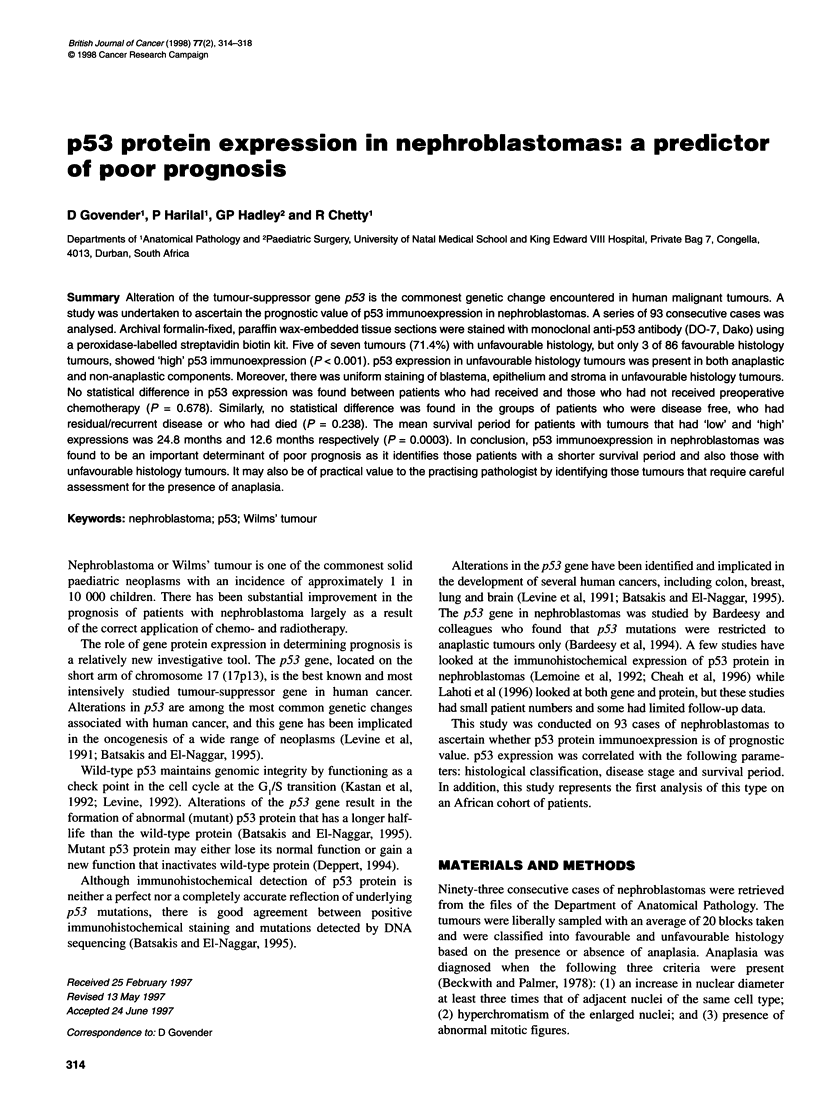
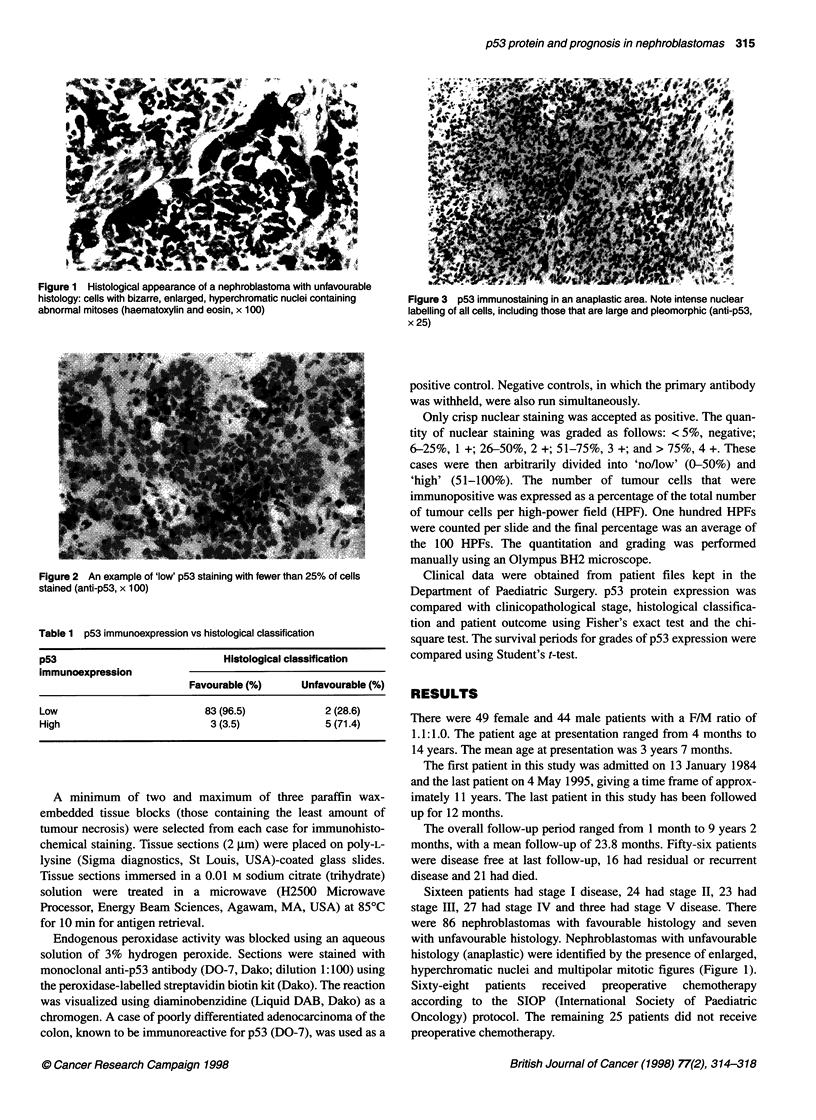
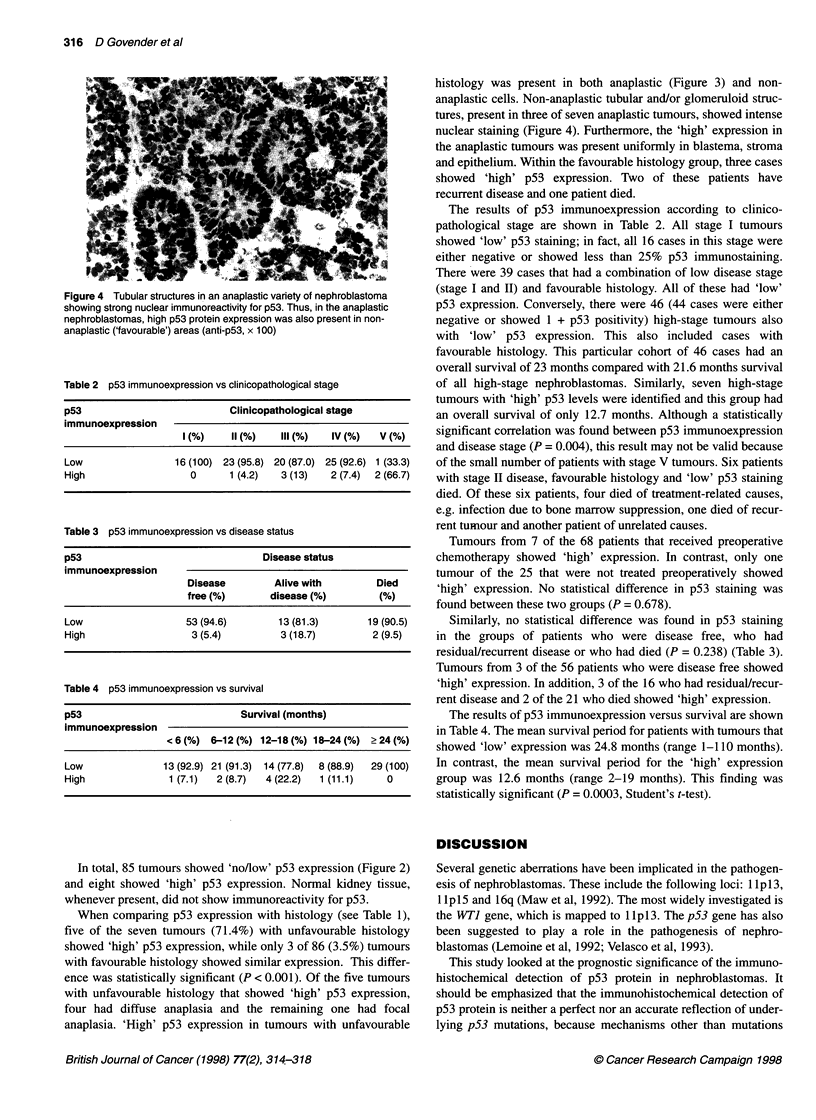
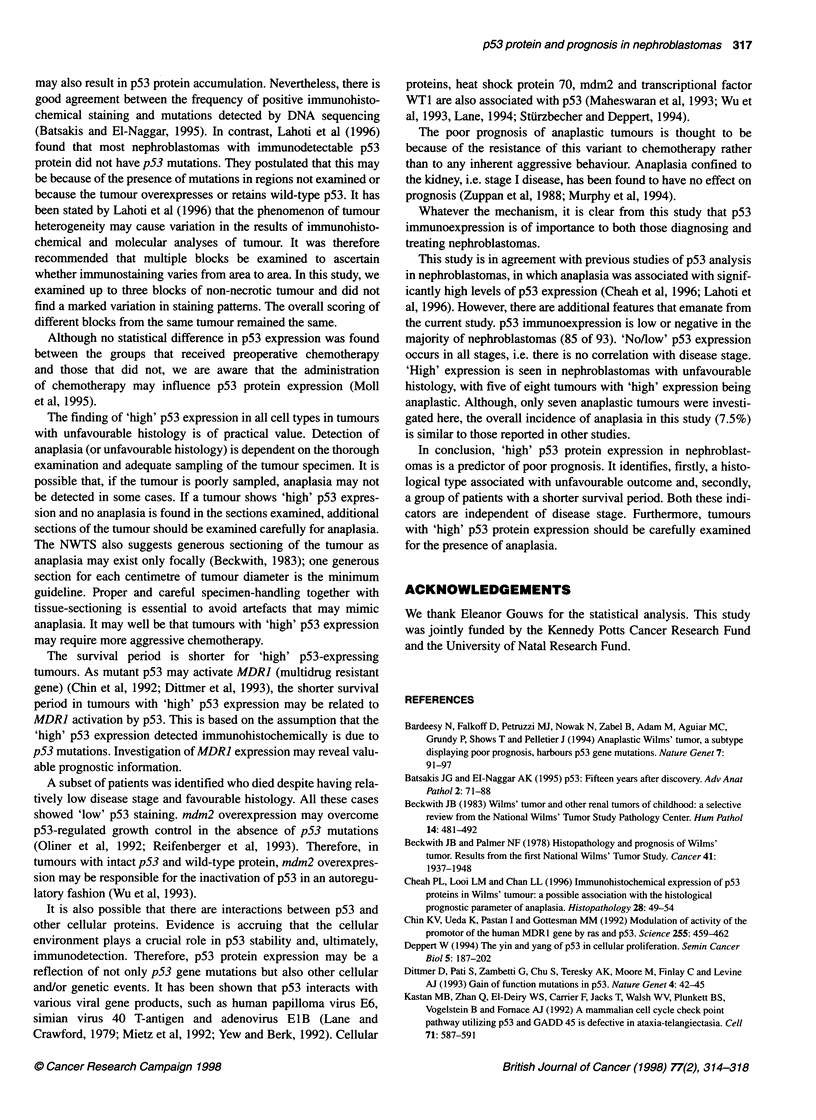
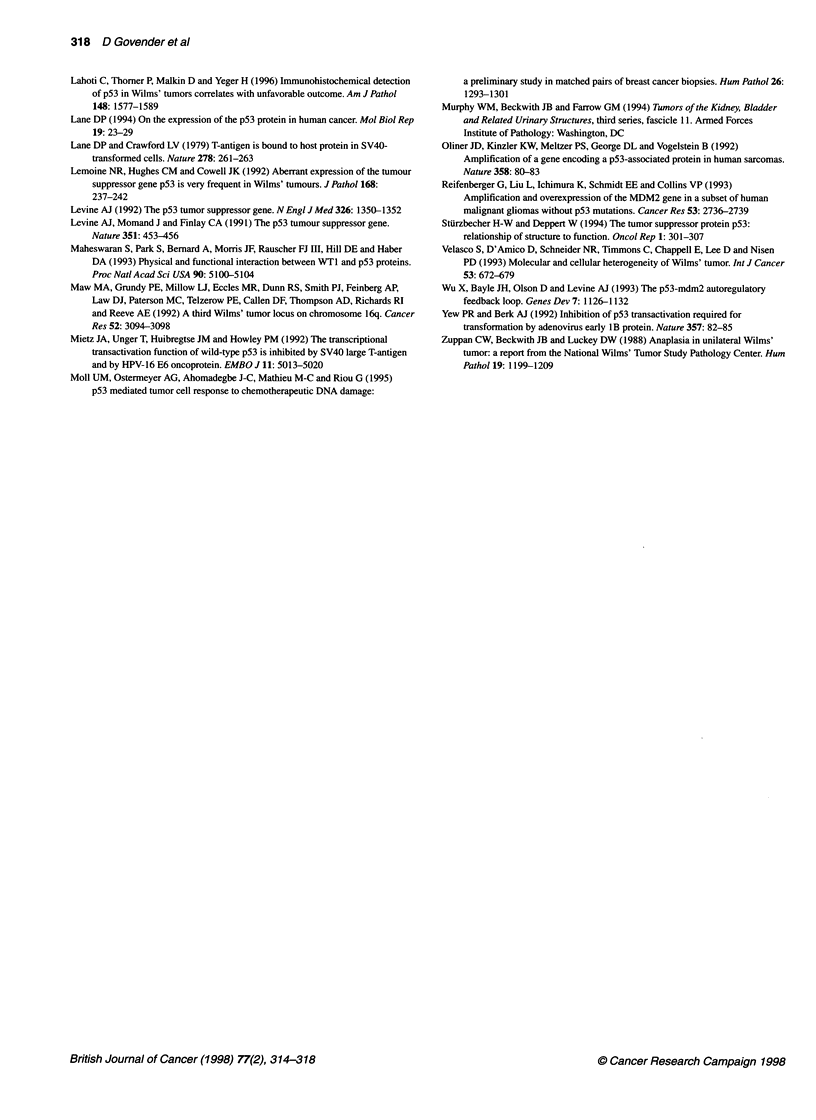
Images in this article
Selected References
These references are in PubMed. This may not be the complete list of references from this article.
- Bardeesy N., Falkoff D., Petruzzi M. J., Nowak N., Zabel B., Adam M., Aguiar M. C., Grundy P., Shows T., Pelletier J. Anaplastic Wilms' tumour, a subtype displaying poor prognosis, harbours p53 gene mutations. Nat Genet. 1994 May;7(1):91–97. doi: 10.1038/ng0594-91. [DOI] [PubMed] [Google Scholar]
- Beckwith J. B., Palmer N. F. Histopathology and prognosis of Wilms tumors: results from the First National Wilms' Tumor Study. Cancer. 1978 May;41(5):1937–1948. doi: 10.1002/1097-0142(197805)41:5<1937::aid-cncr2820410538>3.0.co;2-u. [DOI] [PubMed] [Google Scholar]
- Beckwith J. B. Wilms' tumor and other renal tumors of childhood: a selective review from the National Wilms' Tumor Study Pathology Center. Hum Pathol. 1983 Jun;14(6):481–492. doi: 10.1016/s0046-8177(83)80003-3. [DOI] [PubMed] [Google Scholar]
- Cheah P. L., Looi L. M., Chan L. L. Immunohistochemical expression of p53 proteins in Wilms' tumour: a possible association with the histological prognostic parameter of anaplasia. Histopathology. 1996 Jan;28(1):49–54. doi: 10.1046/j.1365-2559.1996.d01-384.x. [DOI] [PubMed] [Google Scholar]
- Chin K. V., Ueda K., Pastan I., Gottesman M. M. Modulation of activity of the promoter of the human MDR1 gene by Ras and p53. Science. 1992 Jan 24;255(5043):459–462. doi: 10.1126/science.1346476. [DOI] [PubMed] [Google Scholar]
- Deppert W. The yin and yang of p53 in cellular proliferation. Semin Cancer Biol. 1994 Jun;5(3):187–202. [PubMed] [Google Scholar]
- Dittmer D., Pati S., Zambetti G., Chu S., Teresky A. K., Moore M., Finlay C., Levine A. J. Gain of function mutations in p53. Nat Genet. 1993 May;4(1):42–46. doi: 10.1038/ng0593-42. [DOI] [PubMed] [Google Scholar]
- Kastan M. B., Zhan Q., el-Deiry W. S., Carrier F., Jacks T., Walsh W. V., Plunkett B. S., Vogelstein B., Fornace A. J., Jr A mammalian cell cycle checkpoint pathway utilizing p53 and GADD45 is defective in ataxia-telangiectasia. Cell. 1992 Nov 13;71(4):587–597. doi: 10.1016/0092-8674(92)90593-2. [DOI] [PubMed] [Google Scholar]
- Lahoti C., Thorner P., Malkin D., Yeger H. Immunohistochemical detection of p53 in Wilms' tumors correlates with unfavorable outcome. Am J Pathol. 1996 May;148(5):1577–1589. [PMC free article] [PubMed] [Google Scholar]
- Lane D. P., Crawford L. V. T antigen is bound to a host protein in SV40-transformed cells. Nature. 1979 Mar 15;278(5701):261–263. doi: 10.1038/278261a0. [DOI] [PubMed] [Google Scholar]
- Lane D. P. On the expression of the p53 protein in human cancer. Mol Biol Rep. 1994 Jan;19(1):23–29. doi: 10.1007/BF00987319. [DOI] [PubMed] [Google Scholar]
- Lemoine N. R., Hughes C. M., Cowell J. K. Aberrant expression of the tumour suppressor gene p53 is very frequent in Wilms' tumours. J Pathol. 1992 Oct;168(2):237–242. doi: 10.1002/path.1711680213. [DOI] [PubMed] [Google Scholar]
- Levine A. J., Momand J., Finlay C. A. The p53 tumour suppressor gene. Nature. 1991 Jun 6;351(6326):453–456. doi: 10.1038/351453a0. [DOI] [PubMed] [Google Scholar]
- Levine A. J. The p53 tumor-suppressor gene. N Engl J Med. 1992 May 14;326(20):1350–1352. doi: 10.1056/NEJM199205143262008. [DOI] [PubMed] [Google Scholar]
- Maheswaran S., Park S., Bernard A., Morris J. F., Rauscher F. J., 3rd, Hill D. E., Haber D. A. Physical and functional interaction between WT1 and p53 proteins. Proc Natl Acad Sci U S A. 1993 Jun 1;90(11):5100–5104. doi: 10.1073/pnas.90.11.5100. [DOI] [PMC free article] [PubMed] [Google Scholar]
- Maw M. A., Grundy P. E., Millow L. J., Eccles M. R., Dunn R. S., Smith P. J., Feinberg A. P., Law D. J., Paterson M. C., Telzerow P. E. A third Wilms' tumor locus on chromosome 16q. Cancer Res. 1992 Jun 1;52(11):3094–3098. [PubMed] [Google Scholar]
- Mietz J. A., Unger T., Huibregtse J. M., Howley P. M. The transcriptional transactivation function of wild-type p53 is inhibited by SV40 large T-antigen and by HPV-16 E6 oncoprotein. EMBO J. 1992 Dec;11(13):5013–5020. doi: 10.1002/j.1460-2075.1992.tb05608.x. [DOI] [PMC free article] [PubMed] [Google Scholar]
- Moll U. M., Ostermeyer A. G., Ahomadegbe J. C., Mathieu M. C., Riou G. p53 mediated tumor cell response to chemotherapeutic DNA damage: a preliminary study in matched pairs of breast cancer biopsies. Hum Pathol. 1995 Dec;26(12):1293–1301. doi: 10.1016/0046-8177(95)90292-9. [DOI] [PubMed] [Google Scholar]
- Oliner J. D., Kinzler K. W., Meltzer P. S., George D. L., Vogelstein B. Amplification of a gene encoding a p53-associated protein in human sarcomas. Nature. 1992 Jul 2;358(6381):80–83. doi: 10.1038/358080a0. [DOI] [PubMed] [Google Scholar]
- Reifenberger G., Liu L., Ichimura K., Schmidt E. E., Collins V. P. Amplification and overexpression of the MDM2 gene in a subset of human malignant gliomas without p53 mutations. Cancer Res. 1993 Jun 15;53(12):2736–2739. [PubMed] [Google Scholar]
- Velasco S., D'Amico D., Schneider N. R., Timmons C., Chappell E., Lee D., Nisen P. D. Molecular and cellular heterogeneity of Wilms' tumor. Int J Cancer. 1993 Feb 20;53(4):672–679. doi: 10.1002/ijc.2910530425. [DOI] [PubMed] [Google Scholar]
- Wu X., Bayle J. H., Olson D., Levine A. J. The p53-mdm-2 autoregulatory feedback loop. Genes Dev. 1993 Jul;7(7A):1126–1132. doi: 10.1101/gad.7.7a.1126. [DOI] [PubMed] [Google Scholar]
- Yew P. R., Berk A. J. Inhibition of p53 transactivation required for transformation by adenovirus early 1B protein. Nature. 1992 May 7;357(6373):82–85. doi: 10.1038/357082a0. [DOI] [PubMed] [Google Scholar]
- Zuppan C. W., Beckwith J. B., Luckey D. W. Anaplasia in unilateral Wilms' tumor: a report from the National Wilms' Tumor Study Pathology Center. Hum Pathol. 1988 Oct;19(10):1199–1209. doi: 10.1016/s0046-8177(88)80152-7. [DOI] [PubMed] [Google Scholar]






